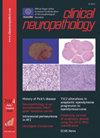家族性肌萎缩性侧索硬化症伴SOD1基因突变的临床表型模拟近端肌病:1例报告和文献复习。
IF 0.8
4区 医学
Q4 CLINICAL NEUROLOGY
引用次数: 0
摘要
肌萎缩侧索硬化症是一种具有强烈临床和遗传异质性的疾病,其发病机制尚未完全阐明。近端肌病在ALS的临床表现中是罕见的。在这里,我们描述了一名34岁的女性,她有1年的对称性、近端肢体无力和肌肉萎缩病史,进展缓慢,没有上运动神经元(UMN)体征。临床表型与肌病相似,最初被误诊为近端肌病。进行肌电图(EMG)和肌肉和神经活检。对患者外周血淋巴细胞的基因组DNA进行了分析。肌电图和病理检查显示慢性神经源性改变和轻度混合性周围神经病变。DNA分析显示,SOD1第1外显子第50密码子(c.50G>c)处有一个杂合错义突变,CPT1C第1013密码子(c.1013G>a)处有第11外显子杂合错义突变,这是以前从未报道过的。该患者被诊断为家族性ALS(FALS)1型,患者有常染色体显性遗传(AD)型家族史。本报告扩展了对FALS临床表型的认识。对于临床表现类似近端肌病的患者,应考虑潜在ALS的可能性。本文章由计算机程序翻译,如有差异,请以英文原文为准。
Clinical phenotype of familial amyotrophic lateral sclerosis with SOD1 gene mutation mimicking proximal myopathy: A case report and literature review.
Amyotrophic lateral sclerosis (ALS) is a disorder with strong clinical and genetic heterogeneity, and its pathogenic mechanism has not been completely clarified. Proximal myopathy is rare in clinical manifestations of ALS. Here, we describe a 34-year-old woman with a 1-year history of symmetrical, proximal limb weakness, and muscle atrophy, with slow progression and no upper motor neuron (UMN) signs. The clinical phenotype was similar to myopathy and was initially misdiagnosed as proximal myopathy. Electromyography (EMG) and muscle and nerve biopsy were performed. The genomic DNA from the patient's peripheral blood lymphocytes was analyzed. The EMG and pathologic examinations revealed chronic neurogenic changes and mild mixed peripheral neuropathy. DNA analysis revealed a heterozygous missense mutation in exon 1 at codon 50 (c.50G>C) of SOD1, and a heterozygous missense mutation in exon 11 at codon 1013 (c.1013G>A) of CPT1C that has not been reported previously. The patient was diagnosed as familial ALS (FALS) type 1, and the patient had a family history of autosomal dominant (AD) pattern. This report expands the knowledge of the clinical phenotype of FALS. For patients with clinical manifestations mimicking proximal myopathy, the possibility of underlying ALS should be considered.
求助全文
通过发布文献求助,成功后即可免费获取论文全文。
去求助
来源期刊

Clinical Neuropathology
医学-病理学
CiteScore
1.60
自引率
0.00%
发文量
70
审稿时长
>12 weeks
期刊介绍:
Clinical Neuropathology appears bi-monthly and publishes reviews and editorials, original papers, short communications and reports on recent advances in the entire field of clinical neuropathology. Papers on experimental neuropathologic subjects are accepted if they bear a close relationship to human diseases. Correspondence (letters to the editors) and current information including book announcements will also be published.
 求助内容:
求助内容: 应助结果提醒方式:
应助结果提醒方式:


